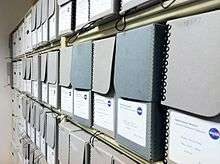NASA Headquarters
Mary W. Jackson NASA Headquarters, better known as NASA Headquarters and formerly named Two Independence Square, is a low-rise building in the two-building Independence Square complex at 300 E Street SW in Washington D.C. The building houses NASA leadership who provide overall guidance and direction to the US government executive branch agency NASA, under the leadership of the NASA administrator. Ten field centers and a variety of installations around the country conduct the day-to-day work.[3]
| Mary W. Jackson NASA Headquarters | |
|---|---|
 | |

| |
| Alternative names | NASA Headquarters Two Independence Square |
| General information | |
| Type | Government offices Commercial offices |
| Location | 300 Hidden Figures Way SW Washington D.C. |
| Coordinates | 38.8830°N 77.0163°W |
| Completed | 1992 |
| Owner | Hana Asset Management[1] |
| Technical details | |
| Floor count | 9 |
| Design and construction | |
| Architect | Evans Heintges Architects Kohn Pederson Fox |
| Developer | Boston Properties |
| References | |
| [2] | |
NASA Headquarters is organized into four Mission Directorates: Aeronautics, Exploration Systems, Science, and Space Operations.
The James E. Webb Memorial Auditorium, named for NASA's second administrator James E. Webb, hosts agency news conferences and NASA Social events. A lending library, the history office, archives, production facilities for NASA TV, and a NASA gift shop are also housed in the building.[4]
The building, which opened in 1992, was designed by Kohn Pedersen Fox, with George How as the senior designer.[5] It is currently owned by South Korean investment firm Hana Asset Management and leased to NASA through 2028.[1]
On June 12, 2019, the street in front of the building was renamed Hidden Figures Way in honor of some of NASA's black women mathematicians, Katherine Johnson, Dorothy Vaughan, and Mary Jackson, who were the central characters in the 2016 film Hidden Figures.[6] On June 24, 2020, NASA Administrator Jim Bridenstine announced that the agency’s headquarters building in Washington, D.C. had been renamed to Mary W. Jackson NASA Headquarters, after NASA's first black woman engineer, Mary W. Jackson.[7]
.jpg) Main entrance
Main entrance.jpg) Lobby during NASA's Day of Remembrance
Lobby during NASA's Day of Remembrance NASA history archives
NASA history archives
References
- "S. Korean Investment Firm Buys NASA HQ in DC". Retrieved 2018-07-29.
- NASA Headquarters at Emporis
- NASA - About NASA Headquarters
- Mather, John C.; Boslough, John (2008). The very first light : the true inside story of the scientific journey back to the dawn of the universe (Rev. and updated. ed.). New York, NY: Basic Books. ISBN 978-0-465-00529-1.
- "George M. How, 35, An Architect, Is Dead". The New York Times. 1993-02-25. Retrieved 2020-07-26.
- "Sign of Progress: Street Renaming Puts NASA Headquarters on Hidden Figures Way". Retrieved 2020-06-25.
- Potter, Sean (2020-06-24). "NASA Names Headquarters After 'Hidden Figure' Mary W. Jackson". NASA. Retrieved 2020-06-24.
External links
| Wikimedia Commons has media related to NASA Headquarters. |
